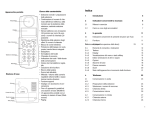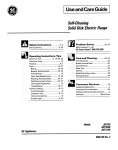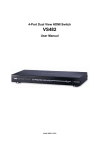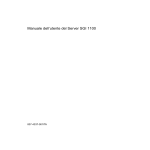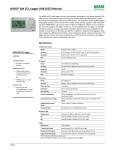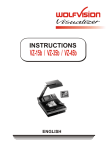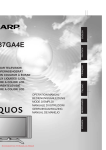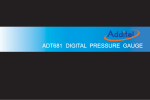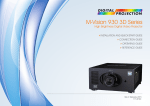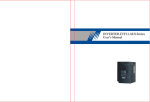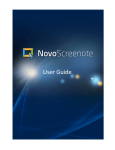Download User`s Manual
Transcript
User’s Manual Contents Start using the projector - Adjustments COPYRIGHT INFORMATION 5 yy Copyright yy Disclaimer yy About this manual 5 5 5y IMPORTANT SAFETY INSTRUCTIONS 6 yy DISPOSAL OF OLD ELECTRICAL AND ELECTRONIC EQUIPMENT yy Important Recycle Instructions: 7 7y INTRODUCTION 8 yy About This Manual yy Description, Features and Benefits yy Parts List 8 8 9y CONTROLS AND FUNCTIONS yy yy yy yy yy 10 D8300 at a Glance I/O Panel KEYPAD To install batteries in the remote control Range of effective remote control signal reception 10 11 12 14 14y Installation Considerations 15 yy yy yy yy yy yy Ambient Light Throw Distance Modes of installation Allow at least 50 cm clearance around the exhaust vent. Do not tilt the projector more than 15 degrees. Other Considerations Lens Shift yy Vertical Lens Shift yy Horizontal Lens Shift Connecting the projector to other devices. yy yy yy yy yy yy HDMI Connection 12V Trigger connection IR Input connection S-VIDEO, VIDEO connection COMPONENT connection RS-232 Controller Connection 15 15 15 16 17 17y 18 18 18y 19 19 20 20 21 21 22 yy yy yy yy yy Connecting to AC Power Turning on the Power Changing the OSD Language Adjusting the Picture Orientation Lens Adjustments Start using the projector - Operation 23 23 23 24 24 25y 26 yy Selecting An Input Source yy Selecting an Aspect Ratio yy Using the OSD 26 26 26y Start using the projector - OSD Introduction 27 yy yy yy yy yy yy yy OSD Menu Tree OSD Introduction - MAIN OSD Introduction - ADVANCE OSD Introduction - SYSTEM OSD Introduction - CONTROL OSD Introduction - LANGUAGE OSD Introduction - SERVICE Change Lamp yy To replace the projector lamp LED Status 27 28 30 33 34 35 36y 38 38y 40 yy POWER yy ISSUE 40 40y SPECIFICATIONS 41 yy Optical yy Electrical yy Physical SERIAL INTERFACE SPECIFICATIONS yy yy yy yy Transfer Specifications RS-232 Commands IR Codes and Key names Operations Commands 41 41 41y 42 42 42 42 43y Dimensions 46 Supported Timings 47 Projection Distance and Screen Size 48 DLP Projector - User’s Manual COPYRIGHT INFORMATION Copyright This publication, including all photographs, illustrations and software, is protected under international copyright laws, with all rights reserved. Neither this manual, nor any of the material contained herein, may be reproduced without written consent of the manufacturer. The Vivitek logo is a trademark of “Vivitek Corporation.” © Copyright 2012 Disclaimer The information in this document is subject to change without notice. The manufacturer makes no representations or warranties with respect to the contents hereof and specifically disclaims any implied warranties of merchantability or fitness for any particular purpose. The manufacturer reserves the right to revise this publication and to make changes from time to time in the content here without obligation of the manufacturer to notify any person of such revision or changes. About this manual This manual is intended for end users and describes how to install and operate the DLP projector. Wherever possible, relevant information such as an illustration and its description has been kept on one page. This printer-friendly format is both for your convenience and to help save paper, thereby protecting the environment. It is suggested that you only print sections that are relevant to your needs. 5 DLP Projector - User’s Manual IMPORTANT SAFETY INSTRUCTIONS Thank you for your purchase of this quality product! For best performance, please read this manual carefully as it is your guide through the menus and operation. 1. Read and Keep these instructions. 2. Heed all warnings. 3. Follow all instructions. 4. Do not use this apparatus near water. and not install near any heat sources such as radiators, heat registers, stoves, or other apparatus (including amplifiers) that produce heat. y DLP Projector - User’s Manual DISPOSAL OF OLD ELECTRICAL AND ELECTRONIC EQUIPMENT (Applicable throughout the European Union and other European countries with separate collection programs) This symbol found on your product or on its packaging, indicates that this product should not be treated as household waste when you wish to dispose of it. Instead, it should be handed over to an applicable collection point for the recycling of electrical and electronic equipment. By ensuring this product is disposed of correctly, you will help prevent potential negative consequences to the environment and human health, which could otherwise be caused by inappropriate disposal of this product. The recycling of materials will help to conserve natural resources. This symbol is only valid in the European Union. If you wish to discard this product, please contact your local authori-ties or dealer and ask for the correct method of disposal. Important Recycle Instructions: 5. Clean only with a dry cloth. 6. Do not block any of the ventilation openings. Install in accordance with the manufacturer’s instructions. 7. Lamp(s) inside this product contain mercury. This product may contain other electronic waste that can be hazardous if not disposed of properly. Recycle or dispose in accordance with local, state, or federal Laws. For more information, contact the Electronic Industries Alliance at WWW.EIAE.ORG. For lamp specific disposal information check WWW.LAMPRECYCLE.ORG. Do not defeat the safety purpose of the polarized or grounding type plug. A polarized plug has two blades with one wider than the other. A grounding type plug has two blades and a third grounding prong. The wide blade or the third prong is provided for your safety. When the provided plug does not fit into your outlet, consult an electrician for the replacement of the obsolete outlet. 8. Protect the power cord from being walked on or pinched particularly at plugs, convenience receptacles and the point where they exit from the apparatus. 9. Only use the attachments/accessories specified by the manufacturer. 10. Use only with a cart, stand, tripod, bracket or table specified by the manufacturer or sold with the apparatus. When a cart is used, use caution when moving the cart/apparatus to avoid injury from tip-over. y 11. Unplug this apparatus during lightning storms or when unused for long periods of time. y 12. Refer all servicing to qualified service personnel. Servicing is required when the apparatus has been damaged in any way, such as power supply cord or plug is damaged, liquid has been spilled or objects have fallen into the ap-paratus, the apparatus has been exposed to rain or moisture, does not operate normally, or has been dropped. 13. The +12V trigger only outputs 12V DC signal for triggering. Do not connect to any other power input or output. This could cause damage to this unit. 14. Keep the packing material in case the equipment should ever need to be shipped. 15. Never look into the lens when the projector is on.y AVOID EYE CONTACT TO THE LIGHT 6 7 DLP Projector - User’s Manual INTRODUCTION About This Manual This User’s Manual describes how to install, set up and operate the D8300. Throughout this manual, the Projector is referred to as the “D8300.” Target Audience Vivitek has prepared this manual to help installers and end users get the most out of the D8300. Vivitek has made every effort to ensure that this manual is accurate as of the date it was printed. However, because of ongoing product improvements and customer feedback, it may require updating from time to time. You can always find the latest version of this and other Vivitek product manuals on-line, at www.vivitekcorp.com. Description, Features and Benefits The Vivitek D8300 provides state-of-the-art technology for 1080P picture performance, Full HD (1920 x 1080) native resolution for crystal clear, pristine images. The D8300 offers incredibly high definition images at today’s highest available resolutions. Equipped with precision optics, the D8300 includes zoom, focus and lens shift controls for a throw range of 1.85:1 to 2.40:1. For a smaller throw distance (1.56:1 to 1.86:1), the D8300 can be fitted with a varying optics package (optional) to meet different requirements. Exceptional scaling and film-to-video (3:2 pull-down) conversion is easily achieved. Combined with Vivitek’s sophisticated parameters for white balancing, the D8300’s proprietary deinterlacing technology provides the highest level of devel-opment for gray-scale and color balancing and artifact-free images. Completing this engineering marvel are discrete infrared (IR) and RS-232 control, power and source selection controls for seamless, flexible operation. DLP Projector - User’s Manual Parts List Your D8300 is shipped with the following items, if any items are missing or damaged, please contact your dealer or Vivitek Customer Service. yy DLP Projector x 1 yy Wrench x 1 yy Power Cable y USA x 1y China x 1y Europe x 1 yy Remote Control x1y Batteries x 2 yy CD x 1 yy Warranty Card y China x 1y USA x 1y Europe x 1y Taiwan x 1y Other x 1 yy INSP. Card x 1 yy China RoHS Card x 1 Key Features and Benefits The D8300 offers these key features and benefits: yy Native Resolution: 1920 x 1080 (16:9 Native Aspect Ratio) yy DLP system using high-performance Digital Micromirror Device (DMD) yy Two (2), HDMI 1.3 Inputs with High-bandwidth Digital Content Protection (HDCP) yy HDTV Compatible yy Excellent Video Processing on progressive and interlaced video inputs. Green Product with: yy yy yy yy Lead free solder used for soldering including circuit and component electronics. Lead free glasses and coatings. Recycled paper used in the user manuals and packing cartons. Energy Saving: High efficiency power switching and less than 1W power consumption in standby mode. Additional Features of the D8300 yy Horizontal and vertical lens shift yy Keystone adjustment 8 9 DLP Projector - User’s Manual DLP Projector - User’s Manual CONTROLS AND FUNCTIONS I/O Panel y D8300 at a Glance yy Vertical Shift adjustment Refer to “Vertical Lens Shift” on page 18 Vertical Shift adjustment Horizontal Shift adjustment yy Horizontal Shift adjustment Refer to “Horizontal Lens Shift” on page 18 yy Focus ring Rotate this to focus the projected image. yy Zoom ring Rotate this to change the projected image size. Adjustable feet*4 Zoom ring Focus ring yy Air outlet Warm air exits the projector through this vent. Ensure that it is not blockedy Air outlet Air inlet Air outlet yy Air inlet Internal fans draw cool air into the projector through this vent.y yy Adjustable feet Use these when the projector is installed in a tabletop configuration to level the image and/or adjust the projection angle yy Lamp Cover Refer to “To replace the projector lamp” on page 38. Lamp Cover Air inlet yy Power Inlet For input power from wall outlet to projector.y Power inlet Air inlet Rear Infre-red window Kensington Lock (remote control) 103.4 yy Kensington Lock If you worry the security problem, attach the projector to a permanent object with the Kensington slot and a security cable. y 56.4 181.4 yy Rear Infre-red window For receive the remote controller’s message.y y 327 M6xL10 Use screw x 3pcs (M6, Lenght=10mm) to fix this machine on the ceiling mount. yy RS-232 9-pin D-sub connector for interfacing with a PC or home theater automation/control system.y yy TRIGGER 1 , TRIGGER 2 (3.5-mm, mini phone jack) Offers 12 (+/- 1.5) V of output for 350mA monitor relay with short circuit protection.y yy IR INPUT Wired input from a Niles- or Xantech-compatible, infrared (IR) repeater system. y yy S-VIDEO A standard S-Video input for connecting a DVD player, satellite receiver or Super VHS (S-VHS) VCR. y yy VIDEO Standard composite video input for connecting a VCR, laser disc player or other composite video source. Also pro-vides composite sync input for RGBS sources. y yy COMPONENT 1/SCART (RCA connectors) Standard or high-definition (480i/480p/576i/576p/720p/1080i/1080p) Component (YPbPr) input for connecting a DVD/HD-DVD/BD player, HD set-top box or other SD/HD source. Also provides RGB input for RGBS sources.y yy COMPONENT 2 Three BNCs for connecting component (YPbPr) video sources. y yy RGB Provides a standard, 15-pin VGA-style connection to either an RGB or component high-definition source, or to a personal computer. y The D8300 automatically detects the input signal resolution. y yy HDMI1, HDMI2 For connect the device which have HDMI output connectors. 153.4 Ceiling mount dimension 10 11 DLP Projector - User’s Manual DLP Projector - User’s Manual KEYPAD Remote control ● ● SOURCE SOURCE MENU MENU T LEC SE POWER ISSUE OFF ● ● POWER POWER T LEC SE ON HDMI1 HDMI2 RGB COMP1 COMP2 VIDEO ● ● POWER ISSUE LED STATUS ● LED STATUS y MENU Pressthis button to show or hide the OSDmenu. y SELECT, p, q, t, u Use these buttons to select items or settings, adjust settings or switch display patterns. y SOURCE Pressto select a video source.HDMI1,HDMI2,RGB,COMP1,COMP2,VIDEOor S-VIDEO. y Power Use the button to turn on/off the projector. y LED STATUS Refer to “LEDStatus” on page 40 ● ● USER 1 USER 2 TEMP CONT BRIGHT SHARP ● ● GAMMA OS NR ● PIP SWAP MP ● ● ● ● ● ON Use this button to turn the projector on. OFF Use this button to turn the projector off. HDMI1, HDMI2, RGB, COMP1, COMP2, VIDEO Pressto select a input source. ENTER,p, q, t, u Usethese buttons to select items or settings, adjust settings or switch display patterns. ENTER: Pressto select a highlighted menu item or confirm a changed setting. Aspect Ratio SelectionButton: Pressthis button repeatedly to select one of the follow ing aspect ratios: • 16: 9: Forviewing 16:9DVDsor HDTVprograms in their native aspect ratio. MENU Pressthis button to show or hide the OSDmenu. USER1,USER2 Pressto recall settings for the current input from one of two memory presets.By default, these buttons are assignedas follows: M1= User Memory 1;M2 = User Memory 2. However, you can assign each button to any memory preset you wish. Temp This function is not availabel for this model. CONT Adjust the Contrast value using t or u to highlight the differences between light and dark areas of the picture. BRIGHT Adjust the Brightness value using t or u to lighten or darken the pic-ture. SHARP Adjust the Sharpnessvalue using t or u to sharpen or blur the borders between colors and objects. GAMMA adjustment to the light intensity (brightness) of an image in order to match the source more closely. OS Pressto select an overscanmode Note:When Native aspect is selected,Zoom is no available NR Pressto adjust noise reduction level. PIP This function is not availabel for this model. SWAP This function is not availabel for this model. MP Refer to “Menu Position Choosethis function to decide the OSDmenu’s position.” on page 33 Notes on Remote Control Operation ● ● ● 12 In most situations, you can simply point the remote control at the screenwhich will reflect the IR signal from the re-mote back toward the IR receiver on the projector. In some cases,however, ambient conditions may prevent this. If so, point the remote control at the projector and try again. If the effective range of the remote control decreases,or it stops working, replacethe batteries with new ones. The remote control may fail to operate if the infrared remote sensoris exposed to bright sunlight or fluorescent lighting. 13 DLP Projector - User’s Manual DLP Projector - User’s Manual To install batteries in the remote control STEP 1 STEP 2 STEP 3 Installation Considerations Proper installation of your projector will ensure the quality of your display. Whether you are installing a projector temporarily or permanently, you should take the following into account to ensure your projector performs optimally. Ambient Light In general, minimize or eliminate light sources directed at the screen. Contrast ratio in your images will be noticeably reduced if light directly strikes the screen, such as when a shaft of light from a window or floodlight falls on the image. Images may then appear washed out and less vibrant. Requires separate room Installation cost is usually higher 1. Slide the battery compartment cover in the direction of the arrow to remove it. 2. Install two AA batteries with the correct polarity. 3. Replace the cover. Notes on Batteries yy Make sure that the battery polarities are correct when installing the batteries. yy Do not mix an old battery with a new one or different types of batteries. yy If you will not use the remote control for a long time, remove the batteries to avoid damage from battery leakage. Throw Distance Throw distance is the distance measured from the front of the projector to the screen. This is an important calculation in any projector installation as it determines whether or not you have enough room to install your projector with a desired screen size and if your image will be the right size for your screen. You can quickly estimate the throw distance by taking the width of the screen and multiplying it by the lens throw ratio; see Figure 3-2. The result of this calculation tells you roughly how far back the projector should be positioned from the screen in order to project a focused image large enough to fill the screen. Throw Distance (TD) = Screen Width (W) x Throw Ratio (TR) Scree n Width Range of effective remote control signal reception w ro Th Dis ) TD e( c tan (W) Two models of the D8300 are available, one with 1.56-1.86:1 lens and the other with 1.85-2.40:1 lens With optional zoom adaptors throw ratios of 1.24 – 3.0 can be achieved. The standard D8300 offers throw ratios between 1.85:1 and 2.40:1. With the optional, short-throw lens, the D8300 offers throw ratios between 1.56:1 and 1.86:1. 2m 1 40° Modes of installation Frontal projection - desktop installaion Advantages: easy to install can be easily moved or adjusted easy to operate. IR Reception effective Angles: 40° IR Reception effective distance: 12m Note: Avoid placing the remote control at places of high temperature or humidity as it could cause the remote control to malfunction. r Rear projection - desktop installaion Advantage: the projector is completely hidden from plain view the projector can be easily operated this setup usually offers better reduction of ambient noise. Disadvantage: requires an additional room for installation relatively higher costs for installation. 14 Projec to Disadvantage: occupies floor space and limits seating capacity. Projec to r 15 DLP Projector - User’s Manual DLP Projector - User’s Manual Do not tilt the projector more than 15 degrees. Frontal projection - ceiling mode Advantage: does not occupy floor space does not draw attention to it.Eliminates the possibility that someone would accidentally move the projector. Disadvantage: stricter installation requirements and conditions; care should be taken during the installation to ensure the projector has been securely mounted. operation of the projector becomes inconvenient without the remote control. The maximum tilt angle for the projector is 15 degrees. When the projector is tilted more than 15 degrees, it will shorten the life of the projector lamp and may lead to other unpredictable damages. Projec to r Can’t >15° Rear projection - ceiling mode Advantage: the projector is completely hidden from plain view this setup usually offers better reduction of ambient noise. Disadvantage: requires an additional room for installation. Stricter installation requirements and conditions; care should be taken during the installation to ensure the projector has been securely mounted. operation of the projector becomes inconvenient without the remote control. Can’t >15° Other Considerations Projec to yy Install the projector in an environment below 35°C (95°F). The projector should be kept clear from sources of heat and / or ventilation openings of air conditioner. yy The projector should be kept away from devices that emit electromagnetic energy, such as motor and transformer. Common devices that emit electromagnetic energy include slideshow system, speakers, power amplifiers and elevators. yy If you choose to install the projector on the ceiling, be sure to use the ceiling installation components manufactured by manufacturer-certified vendors. For details, please contact your local dealer. yy Ensure that the intake vents do not recycle hot air from the exhaust vent.y r Allow at least 50 cm clearance around the exhaust vent. must > 50cm must > 50cm must > 30cm must > 50cm must > 10cm 16 17 DLP Projector - User’s Manual DLP Projector - User’s Manual Connecting the projector to other devices. Lens Shift Vertical Lens Shift The D8300 has a lens shift capability which allows the vertical movement of the image without moving the projector. Lens shift is generally expressed as a percentage of the screen height. For ceiling mounted projectors, the lens can be moved 120% (0.6V) downward, while the lens can be moved 120% (0.6V) up or down on a desktop mounted projector. Proceed as follows to connect the D8300 to your video sources, external controller(s) - if present - and AC power. When connecting your equipment: •Use the correct signal cables for each source. •Ensure that the cables are securely connected. Tighten the thumbscrews on connectors that have them. Connecting Source Components to the D8300 Connect your video sources to the D8300 as shown and described in the sections that follow. HDMI Connection V 0.6V Range o fv lens shif ertical t adjustm ent This illustration shows normal vertical lens shift without the use of special specification lens or projector 0.6 V V Ra n len ge o ad s shi f ver jus ft tic al tm en t 0.6 V note: This is a general example of lens shift. Lenses vary in their shift capabilities. No particular lens or projector is used in this example. Horizontal Lens Shift The D8300 has a lens shift capability which allows the horizontal movement of the image without moving the projector. The lens can be moved 30% (0.15H) to the right or left within the housing. 0.1 5H H 0.1 5H DVI Source(s) (BD/HD-DVD/DVD Player, HD SetTop Box, Game Console etc.) note: This is a general example of lens shift. Lenses vary in their shift capabilities. No particular lens or projector is used in this example. 18 19 DLP Projector - User’s Manual DLP Projector - User’s Manual 12V Trigger connection If your home theatre system includes a projector screen, screen cover or other 12V Trigger equipment, please connect such device/equipment to the projector’s 12V Trigger output as illustrated. After you have done so, Your screen will lower automatically whenever you turn on your projector for your convenience. Retractable screen or other 12V device S-VIDEO, VIDEO connection If the image input device offers both S-Video and Video connection, it is recommended that you choose S-Video to obtain better image quality.If both the S-Video and Video inputs are connected to the projector, the projector will prioritize SVideo signal input and image from the Video input will not be played. Sleeve = Ground Tip = +12V een r c S r cto e j o r P DVD player, VCR, satellite receiver, LD and so forth IR Input connection If infrared signals from the remote control cannot reach the projector due to excessive distance or obstructions such as walls or cabinet doors, you can connect an external IR repeater system to the IR INPUT on the D8300 to extend the range of the remote control. IR sensor Remote control COMPONENT connection Take the 3/5 cabled RGB component video connectors from the source equipment to the projector’s COMPONENT1 SCART or COMPONENT2 jacks. Y Pb Pr IR repeater DTV set-top-box or other component (YPbPr) input source 20 21 DLP Projector - User’s Manual DLP Projector - User’s Manual RS-232 Controller Connection Connect a PC or home theater control/automation system (if present) to the RS-232 port on the D8300. Use a standard, 9-pin serial cable, wired straight-through. Start using the projector - Adjustments Connecting to AC Power The D8300 ships with various types of AC power cords. Choose the one that is appropriate to your locale. Plug the female end of the power cord into the AC receptacle on the rear of the projector (AC 100V ~ 240V); Then, connect the other end to your AC power source. Desk Top or Notebook Turning on the Power Press the on button on Remote controller. The power LED indicator flashes green to indicate that it is warming up. When the projector is ready for use, the LED indicator turns off, and the projector lights. button on the remote control to turn on the D8300. SOURCE SOURCE MENU T LEC SE POWER or ISSUE ON OFF HDMI1 HDMI2 RGB COMP1 COMP2 VIDEO ISSUE POWER LED STATUS LED STATUS POWER LED Flash Blue clolor 22 POWER POWER T LEC SE MENU Press Power 23 DLP Projector - User’s Manual Changing the OSD Language The D8300 can display the menus in English, Simplify Chinese. Press MENU to display the OSD, Press to select LANGUAGE item, then press to select a language that you wanted. Then press ENTER to confirm your selection. DLP Projector - User’s Manual Lens Adjustments The D8300 gives you a great deal of control over the picture size, position and focus. Focus To focus the projected image, grasp the lens by the front ring and rotate it. Adjust foot Rotate the 4 feet on projector for image position. Note: Ceiling Mode can’t adjust this function. Vertical Shift adjustment Horizontal Shift adjustment Vertical Lens Shift To shift the projected image vertically, insert the provided hex wrench into the hole at the top of the projector (directly above the lens). Then, turn the wrench as shown to shift the lens in the desired direction. Refer to “Vertical Lens Shift” on page 18 Adjusting the Picture Orientation Horizontal Lens Shift To shift the projected image horizontally, insert the provided hex wrench into the hole at the top of the projector. Then, turn the wrench as shown to shift the lens in the desired direction. Refer to “Horizontal Lens Shift” on page 18 If the D8300 is installed behind the screen, you must change the picture orientation to match the installation method. Refer to “Modes of installation” on page 15. To do this, press MENU on the remote control. Then select SYSTEM -> Rear Projectior -> ON. If the projector is ceiling-mounted, the D8300 will automatically inverts the image. If this automatic inversion is not de-sired, please select Ceiling Mode from the OSD Menu -> SYSTEM -> Ceiling Mode -> ON. Directly insert the wrench into the hole Remove the rubber pad then insert the wrench into the hole. When use hex wrench: 1. you can remove the rubber pad which cover the lens shift hole. then insert the hex wrench into the hole and rotate the wrench to adjust the picture’s position. Suggest you do this action. 2. Or you can directly insert the hex wrench into the hole for adjust the picture’s position. Of course the rebber pad will break a hole. Zoom Focus Zoom To make the picture smaller (zoom out) or larger (zoom in). Rotate the zoom ring in the appropriate direction.. Focus To make the picture clear or Fuzzy. Rotate the Focus ring appropriate direction. 24 25 DLP Projector - User’s Manual DLP Projector - User’s Manual Start using the projector - Operation Start using the projector - OSD Introduction Selecting An Input Source OSD Menu Tree When you turn on the D8300, it switches to the last selected input and looks for a valid signal. Use the input source buttons on the remote control to select an input source directly. HDMI1 HDMI2 RGB Aspect Ratio COMP1 COMP2 VIDEO Memory Selecting an Aspect Ratio Press the aspect ratio button to select the appropriate aspect ratio for the type of program material being Using the OSD 1. MAIN Press the MENU button on the remote control or machine top cover’s keypad to display the OSD main menu. Overscan 2. Press or to select a sub-menu. 3. Brightness Contrast Color Saturation Color Tint Sharpness Noise Reduction Press or to select a sub-menu item. 4. For each sub-menu item, the currently-selected value is highlighted. Press or to choose a setting for that item, and press ENTER on the remote controller or SELECT on the keypad to adjust the value of that item. Source Select 5. If want return to the previous menu, please press MENU. Resync 6. In the Main Menu, press MENU to turn off the OSD menu. The D8300 OSD menus are arranged Color Space Video Standard Gamma ADVANCE RGB Adjust Fine Sync Color Mode 26 16:9y Letterboxy 4:3y 4:3 Narrowy Native Recall Memoryy Save setting 0~200 0~200 Not availabel for this model Not availabel for this model 0~200 0~200 Offy Cropy Zoom HDMI1y HDMI2 RGB COMP1 COMP2 VIDEO ENTER Autoy REC709 REC601 RGB-PC RGB-VIDEO Auto NTSC PAL SECAM CRT Film Video Bright Grahpic Red Offset Green Offset Blue Offset Red Gain Green Gain Blue Gain V Position H Position Phase Tracking Sync Level Bright Mode D65 Mode D65 Color Mode Source Enable HDMI1 HDMI2 RGB COMP1 COMP2 VIDEO S-Video SCART Menu Position SYSTEM Lamp Power Blank Screen Auto Power Off Auto Power On Rear Projection Celling Mode Triggle 1 Triggle 2 Control Auto Source H Keystone V Keystone Language SERVICE Economy Standard Logo Black Blue White ON OFF Lamp 16:9 Letterbox 4:3 4:3 Narrow RS232 ON OFF -35 ~ 0 ~ 35 -20 ~ 0 ~20 English 簡體中文 Model Name Serial Number Software Version Active Source Pixel Clock Signal Format H/W Refresh Rate Lamp Hours Factory Reset Blue Only Altitude Yes No ON OFF 27 DLP Projector - User’s Manual DLP Projector - User’s Manual OSD Introduction - MAIN yy Brightness Use to adjust the level of black in the image to increase or decrease image brightness. yy Contrast Use to adjust the contrast of the projected image. Note: Brightness and Contrast controls are interactive. The screen change to one may require a subtle change to the other in order to achieve the optimum setting. yy Sharpness The adjustment of sharpness primarily changes the value of high frequency detail. Use to adjust it. yy Noise Reduction Use to adjust the noise of the projected image. This function is suitable for the elimination of image noise from interleaving SD input.Generally speaking, reducing image noise will lower the value of high frequency detail and make the image appear more mellow. y yy Overscan Some consumers may use the image that input source is not 16:9, and some programs may not display the edges of the image. Use this function to hide the image edge by choosing one of the following three options:y Off Crop Zoom 4:3 yy ASPECT Ratio This function allow user adjust the picture’s Aspect ratio. The following figure is an example for your reference.y Original input picture Aspect Ratio 16:9 16:9 Aspect Ratio Letterbox 16:9 4:3 Narrow Aspect Ratio 4:3 Aspect Ratio 4:3 Narrow Aspect Ratio Native Native (720p) Source image area Edge Noise Screen (16:9) The part of the picture can not be projected yy Memory Recall Memory: Select this item to recalll the your own setting. Saving setting: You can adjust the OSD’s items by yourself then use this function to save your setting. y y y y 28 yy Source Select This function is same as the hotkey which on Remote controller. You can use Remote controller or this function to select the correct input source. Refer to “Selecting An Input Source” on page 26. yy Resync If the projected image becomes unstable or degraded. Use this function to adjust it. This causes a reacquisition of the present active source. It also changes any Fine Sync setting for this timing to the default setting.y y 29 DLP Projector - User’s Manual DLP Projector - User’s Manual OSD Introduction - ADVANCE Different countries may use different video signal formats. Pleasechoose the video standard in your area. ● Auto The color systems are automatically identified and the format is set accordingly. ● NTSC (National Television SystemsCommittee) This is the standard format used mainly in the United States and Japan. ● PAL (PhaseAlternation By Line) This is the standard used in Europe, Australia and many other parts of the world, typically with a 50Hz frame rate. ● SECAM (Sequential Color With Memory) This is a standard format used mainly in Franceand Russia.Gamma: SelectGamma from the ADVANCED menu to choosea DLPde-gamma curve.Used correctly, the Gamma control can improve contrast while maintaining good details for blacks and whites. If excessambient light washes out the image and it becomes difficult or impossible to seedetails in dark areas,low-er the gamma setting to compensate.This improves contrast while maintaining good details for blacks.Conversely,if the image is washed out and unnatural, with excessivedetail in black areas,increase the setting. Note: Generally speaking, the projector will be able to automatically detect the video standard used in your area. However, there are circumstance where the projector will fail to interpret the video standard used and the user will have to manually configure the video format. If you are unsure of the video standard used in your area, please contact a qualified personnel and inquire about the video standard used in your area. ● ● COLOR SPACE When the source signal for HDMI, RGB,and component connections. You can select different color space for different color performance. ● The default setting, Auto, functions as follows: HDMI:If the Auxiliary Video Information (AVI) infoframe contains color spaceand/or range data, the D8300 uses that information. Otherwise, for RGB sources, the D8300 usesthe RGB-Video color space.Forcomponent SDTV and EDTV resolutions, REC601is used. For other component video resolutions, REC709 is used. RGB:If Hsync or Vsync signals are present, the D8300 uses the RGB-PC color space.Otherwise, REC601 is used for SDTVand EDTV sources, and REC709 for all other sources. Component:For SDTVand EDTV resolutions, the D8300 uses the REC601 color space. For all other resolutions REC709 is used. ● ● In most cases,the Auto setting determines the correct color space to use.If it doesnot, you can force the D8300 to use a specific color space.Chooseone of the following: REC709sets the color space matrix to that defined in ITU-RBT.709. REC601sets the color space matrix to that defined in ITU-RBT.601. RGB-PC uses RGBcolor spaceand sets black at 0,0,0 RGBand white at 255,255,255 RGB,assuming an 8-bit image. 30 Video Standard RGB Adjust For remove any trace of color from the white areas of the projected image. ● Gain Use the Gain controls to correct color imbalances in the bright areas of the image. A good way to do this is to use a test pattern consisting mostly of solid white areas,such as an 80 IRE “window” pattern. If the white areas contain traces of red, green or blue, decrease the Gain for that color. ● Offset Use the Offset controls in the RGB Adjust sub-menu to correct color imbalances in the dark areas of the image. A good way to do this is to use a test pattern consisting mostly of dark gray areas, such as a 30 IRE “window” pattern. If the gray areas contain traces of red, green or blue, decrease the Offset for that color. The Gain controls increase or decrease the full-scale input range; the Offset controls shift the entire range, resulting in a change in brightness. RGB-Video uses RGB color space and sets black at 16,16,16RGB and white at 235,235,235,assuming an 8-bit image, to correspond to the luminance values defined in digital component standards. ● Gamma Different Gamma settings will affect viewers’ perception of the image. Generally speaking, for images that are darker, it is recommended that Gamma be set higher to yield better image quality in darker regions by sacrificing details in brighter areas.In contrast, when projecting brighter images, you can set the Gamma lower to give up details in the darker areas to make the brighter areas (i.e. clouds) more visible. ● CRTsets the gamma to 2.5. ● Film sets the gamma to 2.2. ● Video is similar to Film gamma but differs in dark areas of the image to correspond to the function that video cameras use to create images. ● Bright sets the gamma to 2.0. ● Graphics should only be used for computer presentations that require increased brightness at the cost of grayscale accuracy. Generally, higher Gain settings reduce the image contrast; higher Offset settings reduce the image brightness. ● Fine Sync 31 DLP Projector - User’s Manual To fine-tune the position and other image attributes.y yy V Position: Select this function to adjust the vertical position of the image within the designated image area, up to 25% up or down of the image height.y DLP Projector - User’s Manual OSD Introduction - SYSTEM yy H Position Select this function to adjust the horizontal position of the image within the designated image area, up to 25% right or left of the image width.y yy Phase (for RGB or Component sources) This control adjusts the phase of the pixel sampling clock relative to the incoming signal. Adjust the phase when an RGB or Component image still shows shimmer or “noise” after Tracking has been optimized.y Note: Adjust the Phase after adjusting Tracking (see below). If some shimmer from a video or HDTV source persists, use the Noise Reduction controls to remove high-frequency noise from the signal. yy Tracking (for RGB or Component sources) Tracking determines the frequency of the pixel sampling clock, indicated by the number of incoming pixels per line, so that all pixels generated by a particular source are sampled. y y Steady flickering or several soft vertical stripes or bands across the entire image indicates poor pixel tracking. Proper pixel tracking helps ensure that the image quality is consistent across the screen, that aspect ratio is maintained and that pixel phase can be optimized.y yy Sync Level (for Component sources only) Select Sync Level to adjust the voltage level of the D8300 Sync signal detection circuitry.y y Sync Level adjustment is occasionally necessary when a DVD player or HDTV source signal drops “below black” (for example, during scenes with explosions or when subtitles are present) and causes the projector to temporarily lose sync. If the Sync Level from the source is persistently too low, the projector won’t sync with the source at all.y y The range is from 50 to 256 millivolts (mV) inclusive. The default setting is 240 mV and should rarely require adjustment. y yy Color Mode yy Bright Mode Choose this item to get the Bright color. y yy D65 Mode Color performance between Bright and D65 Color mode.y yy D65 Color Mode Choose this mode to get the beautiful(High saturation) color.y yy Source Enable To enable or disable selection of a picture’s input source. y When the source “ HDMI1” set as off. The input source “HDMI1” will became Gray. Can’t select. y yy Menu Position Choose this function to decide the OSD menu’s position.y yy Lamp Power yy Economy Power-saving mode. Select this lamp output level will reduce lamp’s brightness, but it can prolongs the life of the lamp. This setting is per source, not global, so it can be saved like other user settings. yy Standard Choose this item to run the lamp as bright as possible (400W).y yy Blank Screen Use this function to specify the content or color to be displayed on the blank screen when no input signal is available. You can choose from Logo, Blue, Black, White.The default value is Logo. yy Auto Power Off The default value is OFF. If you set it to ON, the projector will automatically shut down after 20 minutes without input signal. y y y y 32 33 DLP Projector - User’s Manual yy Auto Power ON The default value is Off. If you set it to ON, the projector will automatically start up when it is connected to AC power. If you plug the projector’s power cord into an AC socket with a switch, you can use this function to start up the projector using the socket’s switch instead of the remote. If you do not need this function, please set it to Off. yy Rear Projection This control reverses all images and menus, and is necessary when the projector is used in rear-projection applications. The default is Off. Refer to “Modes of installation” on page 15. yy Celling Mode This control flips the image so the projector can be used in ceiling mounted installations. The default setting, Auto, automatically determines the orientation using an internal sensor. Refer to “Modes of installation” on page 15. DLP Projector - User’s Manual yy Auto Source Off: d efault setting. By enabling this function, the projector will automatically determine the source of input every time it is turned on so that the user will not have to make the selection on the OSD Menu. y y Setting the function off will require the user to specify source of image input on the OSD Menu in order for the projector to display the intended image.y yy H Keystone , V Keyston Use this function to correct keystoning caused by projection angle.y V Keystone 20 H Keystone -35 OSD Introduction - CONTROL H Keystone V Keystone 0 H Keystone 35 V Keystone -20 OSD Introduction - LANGUAGE yy Triggle 1, Triggle 2 The projector comes with two sets of Trigger output. You can configure two different devices connected to the projector via the trigger ports to be automatically turned on when the projector is on. There will be a 2-3 second delay prior to activation to prevent operation of this function when the user is choosing the desired aspect ratio.y yy LampOutputs 12V of power on Trigger1 or 2 when the lamp is on. yy 16:9Outputs 12V of power on Trigger1 or 2 when chooses the 16:9 aspect ratio. yy LetterboxOutputs 12V of power on Trigger1 or 2 when chooses the Letterbox aspect ratio. yy 4:3Outputs 12V of power on Trigger1 or 2 when chooses the 4:3 aspect ratio. yy 4:3 NarrowOutputs 12V of power on Trigger1 or 2 when chooses the 4:3 narrow aspect ratio. yy RS232Outputs 12V of power on Trigger 1 or 2 when the projector receive the message from RS232. Choose the OSD display language that you familiar. English or Simple-Chinese. 34 35 DLP Projector - User’s Manual OSD Introduction - SERVICE DLP Projector - User’s Manual yy Blue Only Enabling this option will make the projector display only blue color to facilitate the process of image inspection for the service personnel. For detailed instructions on how to use this function, consult a qualified service personnel.y yy Altitude Use this function to control the projector’s cooling fan. You can set it to Off or On. The default setting is Off. y Under normal circumstances, the projector will operate normally with this function set to Off. By default, the projector will detect the temperature of the surrounding environment to regulate the speed of the cooling fan. When the ambient temperature rises, fan speed will increase (generates louder noise) to make sure the heat inside the projector gets discharged and keep the projector working normally. y y However, if you were to operate the projector in environment of excessive heat or in areas of high altitude, the projector may automatically shut down. When this happens, you can enable this function by setting it to On to force the cooling fan to work at a higher speed to regulate the temperature inside the projector. High altitude region refers to area with elevation over 5000 feet. The functions covered in this unit relate to the display of some basic information about the projector. Memory of the custom timing files will be erased in the Factory Reset operation. yy Model: the designated model number of the projector. yy Serial Number: the designated serial number of the projector. yy Software Version: the version of software installed on the projector. yy Active Source: displays the current PIP sources. yy Pixel Clock: displays the pixel clock of the current input signal. yy Signal Format: displays the format of the current input signal. yy H/V Refresh Rate: displays the horizontal and vertical refresh rates for the current image. yy Lamp Hours Display the lamp usage time. When you change the new lamp. The lamp hours will re-calculate the time.y yy Factory Reset Use this function to restore the configurations in the OSD Menu back to factory default. Note that this function will not apply to items including no signal, network, Projector control, startup Logo, language, High Altitute mode and lamp hours.y When Factory Reset is executed, all source memories created by the projector (i.e. timings files) will be erased. y y 36 37 DLP Projector - User’s Manual Change Lamp DLP Projector - User’s Manual 6. Replace the lamp cover and firmly secure the two screws on the lamp cover. The lifecycle of ordinary projection lamp typically lasts for 1500 hours (Normal mode), 1000 hours(Economy mode) before requiring replacement (different lamp configurations will affect lamp life). From the OSD Menu, you can go to " “OSD Introduction - SERVICE”on page 36 ". to check how long a lamp has been used.You should also replace the lamp when the projected image gets noticeably darker. Contact your local dealer to purchase new certified lamps for your projector. To replace the projector lamp 1. Turn off the projector and unplug the power cord.Let the projector cool for approximately 60 minutes before removing the lamp module for replacement. When you turn off the projector, the lamp inside the projector will still be very hot (approximately 200 ~ 300°C). If you attempt to replace the lamp without allowing the projector to cool, you could risk scalding yourself. This is why you should wait for no less than 60 minutes for the lamp to cool down in order to perform the replacement safely. 2. Loosenthe lamp cover. 3. Use a screw driver to loosen the screws as shwon in the illustration. 4. Grasp the metal rod on the lamp cover and pull the lamp out. 5. Insert the new lamp in the direction shown in the illustration into the lamp assembly;tighten the two screwsusing a screw diver and make sure the lamp is firmly secured to prevent the lamp from shaking or poor contact. 38 39 DLP Projector - User’s Manual DLP Projector - User’s Manual LED Status SPECIFICATIONS POWER ISSUE Optical ● POWER ISSUE ● LED STATUS ● ● LED STATUS ● ● POWER ● ● ● ● ● Turns blue Indicate projector is turned on, and can function properly. Flash blue Indicate the projector is in the warming or cooling time. In this situation, the function of keypad is not available. Off This indicates that the projector has either been turned on and is working normally or the projector is not connected to power. ● Electrical ● ● ● ISSUE ● ● ● ● ● ● ● ● Flashes once in red The projector lamp is faulty; check to see if the lamp is damaged or if it hasn't been properly installed. Flashes twice in red The lamp cover is not properly replaced. Flashes three times in red The cooling fan inside the projector is not working; seek assistancefrom a qualified servicepersonnel. Flashes four times in red The projector temperature is too high; try cleaning the ventilator slots or unplugging the power cord to resolve the issue. Flashes five times in red Theprojector filter might not have been inserted properly; checkthe ventilation slot and make sure the filter has been properly replaced and inserted. Turn Red The projector’s system has problem. Pleasecontact the servicecenter. ● ● ● Red (ISSUE) ● ● Standby Cooling / Warm up Power on / Normal Lamp fail Lamp door open Fan fail Over Temperature Filter fail System Error 40 ● repeat ● repeat repeat repeat Inputs HDMI x 2, RGB,Component x 2,Video, S-Video Pixel clock (digital) up to 165MHz Bandwidth (analog) 200MHz Control inputs 1x RS232 serial: 38400 baud, 8 bits, 1stop bit, no parity 1x remote control Mains voltage 100-240 VAC±10%,47-63Hz (single phase) Power consumption 110V347Win Running mode, 1.9Win Standby 240V 331Win Running mode, 2.5Win Standby International Regulations Meets FCC Class B requirements Meets EMC Directives (EN55022, EN 55024) Meets Low Voltage Directive (EN60950) Indicators Power,Standby,Issue(Fault) Physical ● Blue (POWER) Digital Light Processor1x 0.95” TexasInstruments DMD™,resolution1920x 1080 pixels Colour wheel 6-segment: (RGBYCW)(3x) Contrast Ratio 3000: 1(±10%) Colour temperature Native: 7000°K (±1500°K) Pixel fill factor 87% Lamp power 400W Lamp life (typical) 1500hours Brightness 7000 ANSIlumens (±10%) Uniformity 85% ● Temperature Operating 10 to 35°C Storage -20 to 60°C Thermal Dissipation 1500BTU/hr Humidity Operating 20% to 90% non condensing Storage 10%to 90% Altitude Operating up to 10,000 feet Storage up to 40,000 feet Weight 15kg (33.07lbs) Noise level < 45 dB repeat 41 DLP Projector - User’s Manual DLP Projector - User’s Manual SERIAL INTERFACE SPECIFICATIONS Transfer Specifications Transmission Speed Data Length Parity Stop Bit Flow Control item 38400 bps 8 bit None 1 None Specifications RS-232 Commands There are 2 types of commands: ● Key commands ● Operation commands All commands start with 2 letters as shown in the following: ● “ky” for key commands. ● “op” for operations commands. ● Key Commands The following example is the syntax for key commands: ky <keyname>[CR] Operation source.sel Command =? aspect =? bright contrast sharp nr overscan = ?+ = ?+ = ?+ = ?+ =? resync color.space (execute) =? gamma =? red.off green.off blue.off red.gain green.gain = ?+ = ?+ = ?+ = ?+ = ?+ - IR Codes and Key names Key Code RS232Key name Function KeyWording Description 1 0x01 pow.on Power On ON Turn power on 2 0x09 pow.off Power Off OFF Turn power off 9 10 11 12 13 14 0x1A 0x1D 0x17 0x1F 0x18 0x15 cur.up cur.left enter cur.right cur.down menu Keypad Down Arrow. p Keypad Left Arrow. t Enter ENER Keypad Right Arrow. u Keypad Up Arrow. q Bring Up or CancelMenu Display. MENU Key pad up arrow. Key pad left arrow. Key pad enter. Keypad right arrow. Key pad down arrow. Bring up or cancel menu display Values 0 = HDMI 1 1= HDMI 2 2 = RGB 3 = YPrPb1 4 = YPrPb2 5 = S-video 6 = Video 0 = 16:9 1= Letterbox 2 = 4:3 3 = 4:3 Narrow 4 = Native 0 - 200 0 - 200 0 - 200 0 - 200 0 = Off 1= Crop 2 = Zoom 0 = Auto 1= YPbPr 2 = YCbCr 3 = RGB-PC 4 = RGB-Video 0 = CRT 1= Film 2 = Video 3 = Bright 4 = Graphics 0-200 0-200 0-200 0-200 0-200 Operations Commands The following example is the syntax for operations commands: op <operation> <command> [CR] No. Function Command Action on unit 1 Set =<value> Makes the unit take that value. 2 Get ? Askswhat the current value is. 3 Increment + Adds 1to the current value. 4 Decrement Subtracts 1from the current value. 5 Execute (none) Performs an action. 42 43 DLP Projector - User’s Manual DLP Projector - User’s Manual blue.gain vert.pos horiz.pos = ?+ = ?+ = ?+ - 0-200 0-200 0-200 menu.pos =? auto.pow.off =? auto.pow.on =? rear.proj =? ceil.mode =? model.name ser.number ? ? 0 = Top left 1= Top right 2 = Bottom left 3 = Bottom right 4 = Center 0 = Off 1= On 0 = Off 1= On 0 = Off 1= On 0 = Off 1= On <string> <string> soft.version act.source ? ? h.refresh v.refresh pixel.clock signal lamp.hours Lamp.reset fact.reset altitude ? ? ? ? ? (execute) (execute) =? v.keystone =? h.keystone memory =? =? 44 <string> 0 = HDMI 1 1= HDMI 2 2 = RGB 3 = YPrPb1 4 = YPrPb2 5 = S-video 6 = Video <number> kHz <number> Hz <number> MHz <string> <number> 0 = off 1= on <number> <number> 0 - recall user memory 1 1 - recall user memory 2 45 DLP Projector - User’s Manual DLP Projector - User’s Manual Dimensions Supported Timings Signal Type Resolution 640x480 640x480 640x480 800x600 800x600 800x600 848x480 848x480 PC 1024x768 1280x1024 1280x1024 1280x1024 1600x1200 1680x1050 1920x1080 Apple Mac 640x480 RGBs 1440x480i 1440x576i SDTV 388.2 416.4 182.3 162.5 EDTV HDTV NTSC PAL SECAM 46 Frame rate 59.94 74.99 85 60.32 75 85.06 47.95 59.94 60 60.02 75.02 85.02 60 59.954 47.95 66.59 50 60 50 DVI Video X X X X X X X X X X X X X X X X SCART S-Video HD15-YUV X X X X X X X X X X X X X X X X X X X X X X X X X X X X X X X 480i 576i 480p 576p 1035i 1080i 1080i (Aus) 1080i 1080i 720p 720p 59.94 50 59.94 50 60 50 50 59.94 60 50 59.94 X X X X X X X X X X X X X X X X X X X X 720p 1080p 1080p 1080p 1080p 60 23.98 24 25 29.97 X X X X X X X X X X 1080p 1080p 1080p 1080p NTSCy (M 4.43) PAL (B,G,H,I) PAL (N) PAL (M) SECAM (M) 30 50 59.94 60 59.94 X X X X X X 50 X X 50 59.94 50 X X X X X X HD15RGB X X X X X X X X X X X X X X X X Y-Pb-Pr X X X X X X X X X X X X 47 DLP Projector - User’s Manual DLP Projector - User’s Manual Projection Distance and Screen Size Screen Size: This is the size of the screen not the size of the projection In case of display 16:9 picture on the whole 16:9 Screen 16:9 Screen TR: 1.85~2.4TR = PD / SW Unit: Inch Screen Size Diagonal 60 70 72 80 82 84 90 92 100 106 110 120 123 133 135 150 170 200 250 300 Width 52.29 61.01 62.75 69.72 71.47 73.21 78.44 80.18 80.18 92.38 95.87 104.59 107.20 115.92 117.66 130.73 148.16 174.31 217.89 261.47 Height 29.41 34.32 35.3 39.22 40.20 41.18 44.12 45.10 45.10 51.97 53.93 58.83 60.30 65.20 66.18 73.54 83.34 98.05 122.56 147.07 Projection Distance Min. 96.74 112.87 116.09 128.99 132.21 135.44 145.11 148.34 148.34 170.91 177.36 193.49 198.32 214.45 217.67 241.86 274.10 322.48 403.09 483.71 Max. 125.50 146.42 150.60 167.34 171.51 175.71 188.26 192.44 192.44 221.72 230.09 251.01 257.28 278.20 282.38 313.76 355.59 418.35 522.93 627.52 Diagonal 60 70 72 80 82 84 90 92 100 106 110 120 123 133 135 150 170 200 250 300 Width 1219 1422 1463 1626 1666 1707 1829 1869 2032 2154 2235 2438 2499 2703 2743 3048 3454 4064 5080 5096 Height 914 1067 1097 1219 1250 1280 1372 1402 1524 1615 1676 1829 1875 2027 2057 2286 2591 3048 3810 4572 Min. 2256 2631 2707 3007 3083 3158 3383 3458 3759 3985 4135 4511 4624 5000 5075 5639 6391 7518 9398 11278 Max. 2926 3414 3511 3901 3999 4097 4389 4487 4877 5169 5364 5852 5998 6486 6584 7315 8291 9754 12192 14630 In case of display 16:9 picture on the whole 4:3 Screen 4:3 Screen TR: 1.85~2.4TR = PD / SW Unit: Inch Screen Size Diagonal 60 70 72 80 82 84 90 92 100 106 110 120 123 133 135 150 170 200 250 300 Width 48.00 56.00 57.60 64.00 65.60 67.20 72.00 73.60 80.00 84.80 88.00 96.00 98.40 106.40 108.00 120.00 136.00 160.00 200.00 240.00 Height 36.00 42.00 43.20 48.00 49.20 50.40 54.00 55.20 60.00 63.60 66.00 72.00 73.80 79.80 81.00 90.00 102.00 120.00 150.00 180.00 Projection Distance Min. 88.80 103.60 106.56 118.40 121.36 124.32 133.20 136.16 148.00 156.88 162.80 177.60 182.04 196.84 199.80 222.00 251.60 296.00 370.00 444.00 Max. 115.20 134.40 138.24 153.60 157.44 161.28 172.80 176.64 192.00 203.52 211.20 230.40 236.16 255.36 259.20 288.00 326.40 384.00 480.00 576.00 In case of display 16:9 picture on the whole 4:3 Screen 4:3 Screen TR: 1.85~2.4TR = PD / SW Unit: mm Screen Size 48 Projection Distance 49 http://www.vivitekcorp.com



























